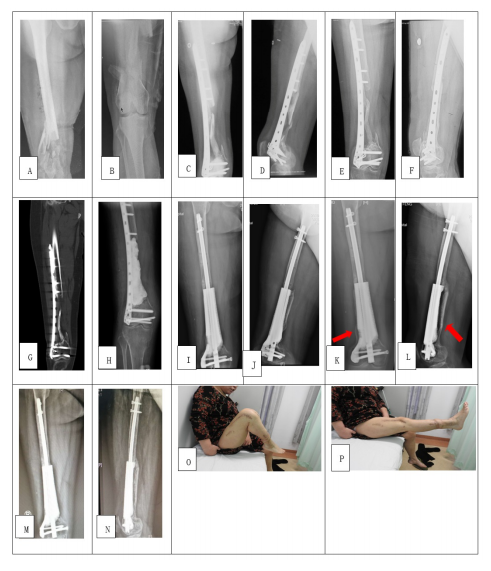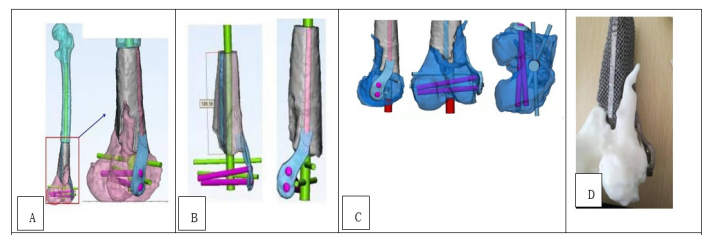Peking University Third Hospital: Case Study of Five Patients with 3D Printed Micro-Porous Prostheses
Researchers from Peking University Third Hospital are focusing on the benefits of 3D printing in orthopedics, outlining their findings in the recently published ‘An innovate strategy to treat large metaphyseal segmental femoral bone defect using customized design and 3D printed micro-porous prosthesis: a prospective clinical study.’
Centered around the safety and functionality of 3D printed microporous prostheses, the study followed patients, each with segmental irregular-shaped bone defect of the femur—usually the result of an infection or traumatic accident. This area is difficult for doctors to treat due to its large area as well its unique shape and what is often major damage regarding mechanical stability for the patient at the metaphyseal area. Challenges are to be found in all traditional areas for treatment, whether in regard to expense or lack of effectiveness in treatment.
3D printing offers new avenues for complex post traumatic limb reconstruction due to the potential for success with patient-specific implants. Investigating further, the researchers conducted their clinical study at Peking University Third Hospital during the 2017-18 period, with participating patients agreeing to try a 3D printed microporous titanium prosthesis combined with intramedullary fixation without bone graft.
Ultimately, five patients with large, irregular-shaped metaphyseal bone defects were recruited, with full understanding of the process, from the surgery to the recovery period. Each patient received a patient specific 3D-printed titanium implant by Shandong Weigao Orthopaedic Device Company Limited featuring adding internal fixation.
The five patients were 52.6 years old, on average, with two men and three women participating. After the case study, they were followed up on for just over 16 months. For most, there was ‘good stability’ following surgery, and Harris hip joint scores were as follows: excellent in 2 cases, good in 2 cases, fair in 1 case. For the HSS score, knee joints were good in four cases, middle in one, and the good rate was 80 percent.
“The design of the implant must take into consideration a number of critical factors including mechanical, anatomical and functional aspects that are unique to each case to allow the composite construct to successfully incorporate,” stated the researchers. “The prosthesis adopts normal dodecahedron element micro-pore design, with porosity of about 70%, pore size of (625 ± 70) µm, elastic modulus of (1200 ± 48) MPa and compressive strength of (66 ± 0.5) MPa.
“The micro-porous designed interface may provide not only torsional resistance, but also limits the potential for shear across the bone/implant interface.”
The prosthesis must be fabricated with the patient’s anatomy and original configuration of bone in mind. Long-bone defects usually present with an irregular-shaped metaphyseal side while diaphyseal sides are more cylindrical. Lateral plates become necessary for added reinforcement when the distal end of the prosthesis is too close to the knee joint—or in the case of inferior distal residual bone quality.
Implants are 3D printed via electron beam melting. After post-processing, they are sent to the surgeon for final inspection before sterilization and implantation in the patient.
“… we found that osteogenesis occurred at the contact end of the bone and prosthesis, callus gradually increased, and crawled along the periphery of the prosthesis and around the contact surface of the prosthesis. Radiographies showed no complications such as implant loosening or subsidence, and our animal experiments showed that osteogenesis was fully inserted into the prosthesis and crawled from both ends into the pore of the prosthesis,” stated the researchers.

A 61ys old male had open fracture of his bilateral femur caused by motor vehicle accident. A: debridement and ORIF have been done. Unfortunately, there was an infectious bone defect. B: debridement of all the infected bone, PMMA spacer and external fixation was done. C: the affected limb is about 3 cm shorter than the contra-lateral limb. D,E: postoperative X-ray showed that the prosthesis matched well with the defect area. F: the length of affected limbs was nearly reconstructed. G,H: 1month post-op X-ray showed good position of prosthesis and internal fixation, callus formation at prosthesis-bone interface (red arrow). I,J: 12months post-op X-ray demonstrated good osseous integration of the prosthesis-bone interface (yellow arrow). No signs of subsidence, implant collapse, or loss of correction. K,L: function of the knee.

A,B: A 42-year-old female have open fracture of her right femur caused by motor vehicle accident 3years ago. C,D: debridement and ORIF have been done. E,F,G: X-ray and CT showed nonunion and large segmental bone defect. Clinical and laboratory examinations exclude infection. H: debridement of the non-viable bone and interposed fibrous tissue,19 PMMA spacer remained in the defect for 8 weeks, during which time the implant was designed and manufactured. I,J: postoperative X-ray showed that the prosthesis matched well with the defect area. K,L: 4 months post-op X-ray showed good position of implant and internal fixation, callus formation(red arrow). M,N: 12-month post-op X-ray demonstrated good osseous integration of the prosthesis-bone interface. No early signs of subsidence, implant collapse. O,P: hip and knee function were good.

A,B: the prosthesis should be configured to mimic the size and shape of the original bone(equal radius of curvature and modulus of elasticity). If the distal end of the prosthesis is too close to the knee joint or the distal residual bone quality is poor, a lateral plate was added to ensure strength. C: 6.5 mm cancellous bone screw should be used for fixation, which should avoid interference with the intramedullary nail locking screw. D: the prosthesis was also validated on the model.
From our study, meticulous custom-designed 3D printing technique of micro-porous prosthesis combined membrane induction and intramedullary fixation may be a cost-effective strategy to treat large metaphyseal femoral irregular-shaped bone defect without bone graft. This may be an alternative treatment for metaphyseal segmental bone defects, especially for cases of massive juxta-articular bone loss.
3D printing of prosthetics is becoming increasingly popular due to the element of customization—and enormous affordability in comparison to traditional techniques—from dental prosthetics to hand prosthetics and projects from organizations like e-NABLE that help people all over the world in need of limb replacements. What do you think of this news? Let us know your thoughts! Join the discussion of this and other 3D printing topics at 3DPrintBoard.com.
[Source / Images: ‘An innovate strategy to treat large metaphysel segmental femoral bone defect using customized design and 3D printed micro-porous prosthesis: a prospective clinical study’]Subscribe to Our Email Newsletter
Stay up-to-date on all the latest news from the 3D printing industry and receive information and offers from third party vendors.
Print Services
Upload your 3D Models and get them printed quickly and efficiently.
You May Also Like
3D Printing News Briefs, June 11, 2025: Sustainability, Automotive Tooling, & More
We’re starting with sustainability news in today’s 3D Printing News Briefs, as EOS has strengthened its commitment on climate responsibility, and Zestep is making 3D printing filament out of eyewear...
3D Printing 50 Polymer Stand-In Parts for Tokamaks at the PPPL & Elytt Energy
Of all the world’s things, a tokamak is one of the hardest, most complex, expensive and exacting ones to make. These fusion energy devices make plasma, and use magnets to...
3D Printing News Briefs, May 17, 2025: Color-Changing Materials, Humanoid Robot, & More
We’re covering research innovations in today’s 3D Printing News Briefs! First, Penn Engineering developed 3D printed materials that change color under stress, and UC Berkeley researchers created an open source,...
Firehawk Aerospace Partners with JuggerBot 3D, Gets $1.25M from AFWERX for 3D Printed Propellants
Texas-based Firehawk Aerospace, an advanced energetic materials firm that works with aerospace and defense applications, announced a strategic partnership with JuggerBot 3D, an Ohio-based large-format 3D printer manufacturer. Together, the...


































